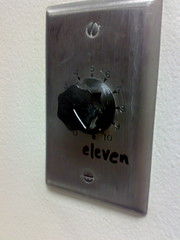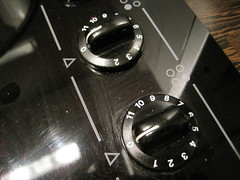 Geeks across teh intertubez are giddy with delight today. Why? Because it’s November 11, 2011, of course! And if you’re in the US, you’d write this as 11/11/11, so of course this tickles the heart of any true mathematically-inclined nerd such as me. now, in the US we put the month first – MM/DD/YY – which is somewhat silly; in England and other realms they write it more logically with the units getting bigger left-to-right, so for them it’s DD/MM/YY, or, contrary to us yanks, 11/11/11.
Geeks across teh intertubez are giddy with delight today. Why? Because it’s November 11, 2011, of course! And if you’re in the US, you’d write this as 11/11/11, so of course this tickles the heart of any true mathematically-inclined nerd such as me. now, in the US we put the month first – MM/DD/YY – which is somewhat silly; in England and other realms they write it more logically with the units getting bigger left-to-right, so for them it’s DD/MM/YY, or, contrary to us yanks, 11/11/11.
OK, so anyway, it’s all ones. Why is that cool?
Well, it just is. Duh. But deep down, this goes to the root (“root”! HAHA! Oh man, I’m a math riot) of how we count. And I am never one to miss a chance to lecture on nerdalicious topics, so stick with me for a bit.
The power of ten compels you!
On the web, which consists of 87% dorks (look it up!), this date is special because it looks binary. For those of you unfamiliar with this, we humans tend to use the number ten as the basis of our counting. Our numbers reflect this: we break things down into powers of ten when we write out a number.
For example, the number 1234 – one thousand, two hundred, thirty-four – has four digits, each representing a power of ten. On the right, we have the “ones” place, where 1 = 100. For our example, there are four of them.
Next, moving left, is the “tens” place, and 10 = 101. For 1234, we have three tens, or thirty.
See how this works? Next is the “hundreds” place, and 100 = 102. Two of those is two hundred.
Last, all the way to the left is the ” thousands” place, or 103. We have one of those, for one thousand.
 Add ‘em together, and you get 1 thousand, 2 hundred, thirty four. This is actually a very clever way to write down a number. Compact, efficient, and makes simple arithmetic possible. It’s not that hard to learn how to add fairly large numbers in your head due to this notation. Try that in Roman numerals!
Add ‘em together, and you get 1 thousand, 2 hundred, thirty four. This is actually a very clever way to write down a number. Compact, efficient, and makes simple arithmetic possible. It’s not that hard to learn how to add fairly large numbers in your head due to this notation. Try that in Roman numerals!
An important note: we use single digits to represent numbers from 0 - 9, then two digits for 10 - 99. Obvious, right? But if you think about it, you’ll see there’s a reason: you don’t need a one digit numeral for “ten”, because it has its own column. Counting up from 0, once you reach the base number of ten you just put a 1 in the next column to the left and a 0 in the column on the right. Simple, neat, and efficient.
I’d even say it’s a brilliant innovation in notation, and is what allows us to represent huge numbers simply. Roman numerals use symbols for certain numbers, and you just mash them together to represent a bigger number (sometimes subtracting them, too, which is truly awful). Our number 1234 would be MCCXXXIV, which is unwieldy. And adding a number to that is completely nonintuitive. It’s more like a code than a system of notation for numbers. Our current method is way, way better. In fact, I’m not really sure why Roman notation is even taught anymore. Seriously, who needs it? Movie copyrighters and SuperBowl fans. That’s about it.
All your base are belong 2 us
But it turns out, you don’t have to use base 10. We have ten fingers, so it’s somewhat natural for us. But in fact other bases are possible, and sometimes even preferred. Like binary.
Binary is the simplest system. It’s base 2. So when you write a number, you use powers of two in the places, not ten. So the columns go from right to left like this:
20 = 1 21 = 2 22 = 4 23 = 8 24 = 16 25 = 32
and so on. You can only use a 0 and 1 in this case, and that makes sense. Why? Because, like base 10, you use a two-digit numeral to represent your base. What we think of as “2” in base ten becomes 10 in binary. It’s the base to the power of 1, just like it is in base 10 (which is called decimal, by the way). I’ll add that when you use the number 10 in decimal you call it “ten”, but when you use 10 in binary you call it ” one zero” to avoid confusion. If you call it “ten” then all the math people will laugh and make fun of you, and not invite you to their Star Trek marathon*.
 In binary, just like in base 10, we add the columns together to make a number. So let’s pick an arbitrary number, like 42†. If we look to the powers of 2, we see it’s 25 (32) + 23 (8) + 21. So we’d write it in base 2 as 101010. You have to put in the zeroes as place holders, or else you can’t see what power is what. But that makes sense: it’s 1 x 25 + 0 x 24 + 1 x 23 + 0 x 22 + 1 x 21 + 0 x 20: 101010.
In binary, just like in base 10, we add the columns together to make a number. So let’s pick an arbitrary number, like 42†. If we look to the powers of 2, we see it’s 25 (32) + 23 (8) + 21. So we’d write it in base 2 as 101010. You have to put in the zeroes as place holders, or else you can’t see what power is what. But that makes sense: it’s 1 x 25 + 0 x 24 + 1 x 23 + 0 x 22 + 1 x 21 + 0 x 20: 101010.
It may seem more cumbersome than base 10, since 42 is only two digits in decimal but 6 in binary. True, but it’s really easy to represent numbers in base 2, since a 0 and 1 can be represented in lots of ways, like an arrow pointing up or down, or a section of a DVD with a tiny laser-burned microscopic pit or no tiny laser-burned microscopic pit, and so on. Anything that exists in two states (on/off, filled/empty) can be used to count in binary. Electric circuits do that, they can be made small and fast, and hey, don’t computers run on electricity?
So yeah. That’s why binary is used in computers.
Will you still need me, will you still feed me, when I’m sixty-three?
And finally, that brings us back to the date! November 11, 2011 is 11/11/11 or just 111111. And that looks like a binary number!
 So what is binary 111111 in decimal form?
So what is binary 111111 in decimal form?
It’s 1 x 20 + 1 x 21 + 1 x 22 + 1 x 23 + 1 x 24 + 1 x 25 = 1 + 2 + 4 + 8 + 16 + 32 = 63.
That’s just one less than the next higher power of two, 64 (26). In binary, a number full of 1s is like a decimal number full of 9s. Add one to it, and you bump up to the next power of your base.
And that’s why some dorks people think today is cool. It’s the last binary number this year, and in fact we can’t get another date that looks like a binary number until 01/01/00, or January 1, 2100! That’s the first day of the last year of the 21st century. It’s a long wait.
And? That date will be 010100, or 20 in decimal.
I don’t know if people will hold binary parties tonight (you can either go or not go) or how they will celebrate – one person on Twitter said he’s getting married today, and I have to admire that – but for me, it’s just fun to think about the numbers.
But then, I’m a dork too.
The Ramans do everything in threes…
So I’ll leave you with a quiz. Base 3 (called ternary) is fun as well, and I don’t want to leave it out!
In base 3, you can use the numerals 0, 1 and 2. As it happens, today’s date consists of those numerals! So we can write out our entire date in ternary, including the full year: 11/11/2011. I ask you: what’s that in decimal? (Those of you who are in other parts of the world, where you’d say it’s 2011/11/11, you’re invited too). You could cheat and look it up online, but that’s no fun. Being a dork means doing it long hand sometimes!
And fun fun fun, as it happens, that ability to use a 2 means more dates in ternary are coming soon. So here’s a semi-trick question: when’s the next all-ternary date?
And, of course: Happy binary 63 day!
Image credits: The Flickr streams of Kichigai Mentat, Joe Shlabotnik, goldberg, and sgilliesm all licensed under Creative Commons.
* Spare me the nerd rage, please. I’ll be watching Stargate.
† OK, so it’s not arbitrary. It’s a pronic number!